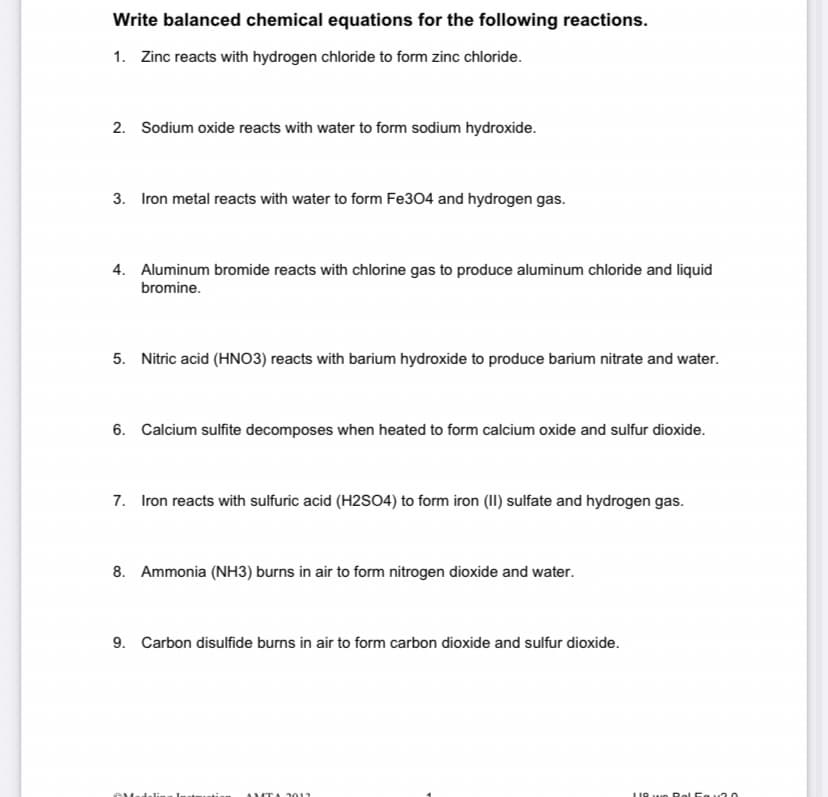Write balanced chemical equations for the following reactions. 1. Zinc reacts with hydrogen chloride to form zinc chloride. 2. Sodium oxide reacts with water to form sodium hydroxide. 3. Iron metal reacts with water to form Fe304 and hydrogen gas.
Write balanced chemical equations for the following reactions. 1. Zinc reacts with hydrogen chloride to form zinc chloride. 2. Sodium oxide reacts with water to form sodium hydroxide. 3. Iron metal reacts with water to form Fe304 and hydrogen gas.
World of Chemistry, 3rd edition
3rd Edition
ISBN:9781133109655
Author:Steven S. Zumdahl, Susan L. Zumdahl, Donald J. DeCoste
Publisher:Steven S. Zumdahl, Susan L. Zumdahl, Donald J. DeCoste
Chapter7: Chemical Reactions: An Introduction
Section7.2: Chemical Equations
Problem 1RQ
Related questions
Question

Transcribed Image Text:Write balanced chemical equations for the following reactions.
1. Zinc reacts with hydrogen chloride to form zinc chloride.
2. Sodium oxide reacts with water to form sodium hydroxide.
3. Iron metal reacts with water to form Fe304 and hydrogen gas.
4. Aluminum bromide reacts with chlorine gas to produce aluminum chloride and liquid
bromine.
5. Nitric acid (HN03) reacts with barium hydroxide to produce barium nitrate and water.
6. Calcium sulfite decomposes when heated to form calcium oxide and sulfur dioxide.
7. Iron reacts with sulfuric acid (H2SO4) to form iron (II) sulfate and hydrogen gas.
8. Ammonia (NH3) burns in air to form nitrogen dioxide and water.
9. Carbon disulfide burns in air to form carbon dioxide and sulfur dioxide.
eMad-lin
AMTA 3012
LI8 ue Rel Eg 30
Expert Solution
This question has been solved!
Explore an expertly crafted, step-by-step solution for a thorough understanding of key concepts.
This is a popular solution!
Trending now
This is a popular solution!
Step by step
Solved in 2 steps

Knowledge Booster
Learn more about
Need a deep-dive on the concept behind this application? Look no further. Learn more about this topic, chemistry and related others by exploring similar questions and additional content below.Recommended textbooks for you

World of Chemistry, 3rd edition
Chemistry
ISBN:
9781133109655
Author:
Steven S. Zumdahl, Susan L. Zumdahl, Donald J. DeCoste
Publisher:
Brooks / Cole / Cengage Learning

Chemistry by OpenStax (2015-05-04)
Chemistry
ISBN:
9781938168390
Author:
Klaus Theopold, Richard H Langley, Paul Flowers, William R. Robinson, Mark Blaser
Publisher:
OpenStax

Chemistry: The Molecular Science
Chemistry
ISBN:
9781285199047
Author:
John W. Moore, Conrad L. Stanitski
Publisher:
Cengage Learning

World of Chemistry, 3rd edition
Chemistry
ISBN:
9781133109655
Author:
Steven S. Zumdahl, Susan L. Zumdahl, Donald J. DeCoste
Publisher:
Brooks / Cole / Cengage Learning

Chemistry by OpenStax (2015-05-04)
Chemistry
ISBN:
9781938168390
Author:
Klaus Theopold, Richard H Langley, Paul Flowers, William R. Robinson, Mark Blaser
Publisher:
OpenStax

Chemistry: The Molecular Science
Chemistry
ISBN:
9781285199047
Author:
John W. Moore, Conrad L. Stanitski
Publisher:
Cengage Learning

Chemistry & Chemical Reactivity
Chemistry
ISBN:
9781337399074
Author:
John C. Kotz, Paul M. Treichel, John Townsend, David Treichel
Publisher:
Cengage Learning

Chemistry & Chemical Reactivity
Chemistry
ISBN:
9781133949640
Author:
John C. Kotz, Paul M. Treichel, John Townsend, David Treichel
Publisher:
Cengage Learning

Chemistry for Engineering Students
Chemistry
ISBN:
9781337398909
Author:
Lawrence S. Brown, Tom Holme
Publisher:
Cengage Learning